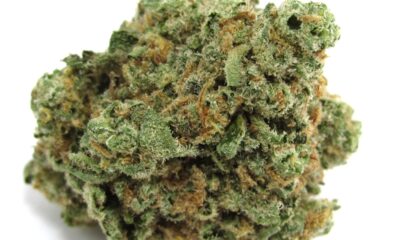Cannabis News
Amendment 3: Florida Legalization Fails
Published
2 months agoon
By
admin
Amendment 3, which would have legalized recreational marijuana for adults in Florida, garnered 55.8% of the vote, falling short of the 60% threshold needed to pass. While the initiative had the support of President-elect Trump, the opposing forces led by Florida Governor Ron DeSantis carried the day. Supporters may draw some comfort from the fact that a clear majority of voters supported legalization, but the fact remains that adult-use cannabis will remain illegal in the Sunshine State for the foreseeable future.
Leaving aside the fact that getting 60% of voters to agree on anything these days appears to be a tall order, Amendment 3 faced active opposition from Florida’s leadership. While themselves driven by a fundamental dislike of cannabis, Gov. DeSantis and his team deftly tapped into concerns that came from different places altogether, such as the lack of provisions for home grow and related concerns over the entrenchment of “Big Weed”.
Looking at the big picture, it is remarkable to see how much Floridians’ attitudes toward cannabis have changed in the past decade. Back in 2014, it was a medical cannabis initiative that fell short of the 60% supermajority requirement. Ten years on, a legal medical marijuana industry is well established in Florida.
Despite the progress, the experience with Amendment 3 suggests that further reliance on the initiative process is not the path forward for legalization advocates. Just getting the proposed amendment on the ballot required overcoming legal challenges from the state government, before addressing the challenge of seeking 60% of votes in the nation’s third-most populated state.
A more sensible approach might be to focus on the fact that legalization is already supported by a majority of Florida voters. For elected officials in large swathes of the state, support for legalization could be a boon. And the fact that concerns over Big Weed control helped defeat opposition to Amendment 3 presents a political opportunity, not for those who double-down on prohibition, but for those who refine approaches to legalization.
We’ll discuss the Florida result on Thursday in a free webinar (register here), along with the disappointing results in North Dakota and South Dakota, the win (for now) in Nebraska, and a few other state and local measures on cannabis regulation. Hope to see you soon.
Cannabis News
Parenting in the New Cannabis Reality
Published
1 hour agoon
January 10, 2025By
admin

Teenagers Whose Parents Are Not Against Cannabis Use Four Times More Likely to Take Drug Says New Study, but Is That a Bad Thing?
Introduction
The landscape of adolescent substance use is continually evolving, particularly with the increasing normalization and legalization of cannabis across various regions. A recent study conducted by researchers at Washington State University has shed light on a interesting trend: teenagers whose parents are not opposed to cannabis use are four times more likely to experiment with the drug. This article delves into the findings of the study, the implications for parents and society, and the broader context of adolescent substance use.
Research Overview
The study, published in the *Journal of Child and Family Studies*, involved a sample of 276 adolescents aged between 13 and 17 years. The researchers aimed to explore the relationship between parental attitudes towards cannabis and adolescent usage patterns. The participants were asked about their perceptions of cannabis, their parents’ views on drug use, and their own experiences with cannabis.
Parental Influence
One of the most striking findings was that teenagers who perceived their parents as accepting or neutral towards cannabis were significantly more likely to have tried the drug themselves. Specifically, those whose parents did not express strong opposition to cannabis use were four times more likely to report having used it. This correlation suggests that parental attitudes play a crucial role in shaping adolescent behavior regarding drug use, but controlling a narrative in their kids reality may be more important than pretending you can stop certain behaviors.
Relationship Dynamics
The study also examined the quality of relationships between parents and their children. Adolescents who reported close relationships with their parents especially those whose parents used cannabis were more likely to view the drug favorably. This finding raises important questions about how parental modeling and communication influence adolescent decision-making.
The Broader Context of Cannabis Use Among Teenagers
As cannabis becomes legalized in more states and countries, its perception as a harmful substance is shifting. Many young people view cannabis as less dangerous than other drugs, a belief that is often reinforced by media portrayals and social acceptance. This normalization can lead to increased experimentation among teenagers, particularly if they feel that their parents are indifferent or supportive of such behaviors.
According to the National Institute on Drug Abuse (NIDA), cannabis remains one of the most commonly used illicit drugs among adolescents in the United States. Recent surveys indicate that approximately 35% of high school seniors reported using cannabis in the past year. The increasing accessibility and changing legal status of cannabis contribute to these rising numbers.
Implications for Parents
Given the findings of this study, it is evident that open communication between parents and teenagers is vital. Parents should engage in discussions about drug use, including cannabis, to establish clear expectations and boundaries. By fostering an environment where teens feel comfortable discussing their thoughts and experiences, parents can help mitigate risks associated with substance use.
Parents must articulate their views on cannabis clearly. While some may feel inclined to adopt a permissive attitude due to changing societal norms, it is essential to consider the potential consequences for their children. Setting firm boundaries can help adolescents navigate peer pressure and make informed decisions about drug use.
Parents serve as role models for their children. If they engage in healthy behaviors and demonstrate responsible decision-making regarding substances, their children are more likely to adopt similar attitudes. Conversely, if parents openly use cannabis or express ambivalence towards its use, they may inadvertently encourage their children to experiment with it.
The Role of Education
Educational institutions play a crucial role in addressing substance use among adolescents. Comprehensive drug education programs can provide students with accurate information about the risks associated with cannabis use and equip them with skills to resist peer pressure. Schools should collaborate with parents to ensure consistent messaging regarding substance use.
Community organizations can also contribute by offering resources and support for families navigating discussions about drug use. Workshops, seminars, and informational sessions can empower parents with knowledge and strategies to engage their children effectively.
The Impact of Legalization on Adolescent Use
The legalization of cannabis for recreational use has sparked debates about its impact on public health, particularly concerning youth. While proponents argue that legalization allows for regulation and education, opponents warn that it may lead to increased accessibility for minors.
Studies examining states that have legalized cannabis indicate mixed results regarding adolescent usage rates. Some research suggests that legalization does not significantly increase teen usage rates; however, other studies highlight a correlation between increased availability and higher rates of experimentation among youth.
Addressing Misconceptions About Cannabis Use
Perceptions vs. Reality
Many teenagers perceive cannabis as a relatively harmless substance compared to alcohol or tobacco. This misconception can lead them to underestimate the potential risks associated with its use, including impaired cognitive function, mental health issues, and addiction.
The Importance of Accurate Information
Parents should strive to provide accurate information about cannabis, including its effects on developing brains and potential long-term consequences. By addressing misconceptions directly, parents can help their children make informed choices about substance use.
Conclusion
The Washington State University study emphasizes the strong impact of parental attitudes on adolescent cannabis use. As societal norms shift, it’s essential for parents to have open discussions with their children about drug use while setting clear boundaries and modeling healthy behaviors. By creating an environment of communication and understanding, parents can reduce the risks associated with adolescent substance use. Additionally, schools and community organizations should collaborate to offer resources that help families navigate these challenges.As cannabis becomes more normalized, prioritizing education, communication, and responsible parenting is crucial for safeguarding future generations’ well-being
THE GUIDE TO PARENTING WITH LEGALIZATION, READ ON..


Running Sober vs. High on Marijuana: How Weed Affects Your Workout
As the cultural and legal landscape surrounding cannabis continues to shift, many fitness enthusiasts are exploring its potential role in exercise routines. A growing number of runners are experimenting with cannabis use before workouts, sparking debates about its impact on physical performance. Does it enhance the experience or hinder results? This article delves into the science behind running sober versus running high, examining how cannabis affects endurance, focus, and overall workout performance.
The Basics of Running Sober
Running sober has long been the standard approach for athletes and fitness enthusiasts. Without external substances, runners rely on their natural physical and mental capacities to perform. This approach offers several benefits:
When running sober, the mind remains clear, allowing athletes to concentrate fully on their pace, breathing, and surroundings. This mental clarity can be crucial for maintaining proper form and achieving peak performance.
Sober running promotes a strong connection between the mind and body. Runners can accurately gauge their exertion levels, recognize signs of fatigue, and adjust their intensity accordingly.
Without the influence of substances, sober runners experience consistent physical responses to training. This consistency makes it easier to track progress, set realistic goals, and develop effective workout plans.
The Basics of Running High
Running high involves consuming cannabis before a workout, typically through smoking, vaping, or ingesting edibles. Advocates claim that cannabis can enhance the running experience in various ways:
Cannabis is known for its analgesic properties, which can help reduce muscle soreness and joint pain. Some runners report that cannabis allows them to push through discomfort and extend their workouts.
Cannabis can create a sense of euphoria or relaxation, often referred to as a “runner’s high.” For some, this altered perception makes running feel more enjoyable and less monotonous.
Cannabis may enhance the brain’s ability to enter a state of flow, where the runner feels deeply immersed in the activity. This can lead to creative thinking and a stronger connection to the running experience.
The Science of Cannabis and Exercise
To understand the effects of cannabis on running, it’s essential to examine its active compounds and how they interact with the body.
Cannabis contains two primary compounds that affect physical and mental states which are:
-
THC (tetrahydrocannabinol): The psychoactive component responsible for the “high.” THC alters perception, mood, and coordination.
The ratio of THC to CBD in a cannabis product significantly influences its effects on a workout. Products high in THC may impair coordination, while CBD-dominant options can provide relief from pain and inflammation without causing a high.
The body’s endocannabinoid system plays a crucial role in regulating mood, pain, and inflammation. Cannabis interacts with this system, potentially enhancing its natural functions. For instance, the endocannabinoids released during exercise are thought to contribute to the “runner’s high.”
Benefits of Running High
Proponents of running high argue that cannabis offers unique benefits that can enhance the workout experience:
Cannabis’s analgesic properties make it an attractive option for runners dealing with chronic pain or soreness. By reducing discomfort, it allows athletes to train longer and recover faster.
For some, running high turns a mundane workout into an enjoyable experience. The euphoric effects of THC can make runners feel more motivated and engaged.
Cannabis’s calming effects can help reduce pre-run anxiety, particularly for individuals preparing for races or long-distance runs. This relaxation can improve performance by preventing tension and overexertion.
Should You Try Running High?
If you’re considering running high, it’s essential to approach it with caution. Start with a low dose of cannabis in a safe and familiar environment. Pay attention to how your body responds and avoid using cannabis before races or high-stakes training sessions.
Risks and Drawbacks of Running High
Despite its potential benefits, running high comes with significant risks that runners should consider:
THC can impair motor skills and reaction times, increasing the likelihood of injuries or accidents during a run. This is especially dangerous for outdoor runners navigating traffic or uneven terrain.
Cannabis may distort a runner’s perception of effort, leading them to overexert or underestimate their limits. This can result in fatigue, dehydration, or even injury.
Smoking or vaping cannabis before running can irritate the lungs and reduce oxygen intake, negatively affecting endurance and performance.
In regions where cannabis use is prohibited, running high may carry legal consequences. Additionally, athletes competing in regulated events risk disqualification if cannabis use violates anti-doping rules.
Comparing the Two (Running sober vs high)
Performance: Running sober often leads to more predictable performance, as cannabis can either enhance or hinder depending on tolerance and strain.
Safety: While weed may reduce pain, it can impair judgment, making it harder to gauge limits or react to sudden changes in the environment.
Mental State: Some runners find that cannabis helps them relax and overcome pre-run anxiety, while others feel it clouds their mental clarity.
Conclusion
The decision to run sober or high is deeply personal and depends on individual preferences, goals, and circumstances. Running sober offers consistency, clarity, and safety, making it ideal for competitive athletes and those focused on measurable progress. On the other hand, running high can enhance enjoyment, reduce pain, and provide a unique mental experience, making it appealing for recreational runners.
Ultimately, the key is to approach cannabis use thoughtfully and responsibly. Whether you choose to lace up your running shoes sober or high, prioritizing safety and listening to your body will help ensure a rewarding workout experience.
RUNNERS AND MARIJUANA, READ ON…
HOW DOES A RUNNER’S HIGH REALLY WORK? CLICK HERE!
Cannabis News
Two Economic Forces That are Reshaping America
Published
2 days agoon
January 8, 2025By
admin

Two Sectors of Society that’s Not Going Away…
You know that feeling when you’re comfortably high and suddenly have an epiphany about how rapidly the world is changing? Well, that’s exactly what happened to me recently while scrolling through Reddit, watching two separate conversations unfold about AI and cannabis – perhaps the two most transformative forces reshaping our society today.
The pace of change is dizzying, isn’t it? We’re living in an era where technological advancement isn’t just rapid – it’s exponential. Before we can fully grasp one innovation, three more have already emerged. And while some folks are still debating whether to embrace these changes, the train has not only left the station, it’s broken the sound barrier.
I found myself in the middle of a heated debate about AI in publishing, with some traditionally-minded writers clutching their pearls at the mere mention of using artificial intelligence in the creative process. The irony wasn’t lost on me – here they were, arguing on a digital platform about the evils of digital progress. Meanwhile, in another corner of Reddit, I stumbled upon a discussion about cannabis stocks, with one astute observer noting, “Cannabis ain’t going anywhere…”
And you know what? Both these threads got me thinking. These two sectors – AI and cannabis – share something fascinating in common: they’re both unstoppable forces that are fundamentally altering how we live, think, and interact with the world. Whether you’re excited about it or terrified, both are here to stay. The only real question is how we choose to integrate them into our society.
So pack a bowl, fire up your neural networks (both biological and artificial), and join me as we explore these transformative forces reshaping our world. Trust me, this is going to be one hell of a trip through the intersection of technology, consciousness, and social change.
Let me tell you something about revolution – it doesn’t always come with a bang. Sometimes it creeps in slowly, one dispensary at a time, one changed mind at a time, until suddenly you look around and realize the world isn’t what it used to be. That’s exactly what’s happened with cannabis over the past two decades.
Remember when California was the lone wolf with its medical marijuana program? These days, you can walk into a dispensary in more than half of U.S. states and legally purchase cannabis. Hell, you can even light up legally in Germany now. The transformation has been nothing short of remarkable, even if 2024 saw a slight slowdown in the legalization momentum. But make no mistake – this train isn’t stopping. It might hit some speed bumps, but it’s still chugging along toward full legalization.
Now, I know what you’re thinking: “But Reg, what about the upcoming Trump administration? Won’t that put the brakes on everything?” Look, I’ve spent enough time analyzing cannabis policy to know that nothing’s certain in politics. But here’s the interesting part – there’s actually some reason for optimism. With RFK Jr. potentially heading up Health and Human Services, we might see some surprising moves. I’ve written before about how a well-crafted legalization plan could actually be a winner with a Republican-controlled government. Tax revenue, states’ rights, personal freedom – these are concepts that resonate across party lines.
But let’s be real for a minute. Whether it happens under Trump or the next administration or the one after that, cannabis legalization is inevitable. You can’t put this genie back in the bottle. We’re talking about an industry generating billions in legal revenue annually. The cannabis sector isn’t just some hippie dream anymore – it’s a serious economic force with real jobs, real tax revenue, and real political clout.
And here’s the kicker – demographics are destiny. The reefer madness generation is fading away, replaced by millennials and Gen X parents who’d rather spark a joint than open a bottle of wine after putting the kids to bed. Cannabis has been normalized to a degree that would have been unthinkable twenty years ago. When soccer moms are discussing their favorite strains at PTA meetings and grandma is using CBD for her arthritis, you know the cultural shift is complete.
The future is clear: federal legalization in the U.S. is coming, and international legalization will follow. It’s not a matter of if, but when. And when that day comes, we’ll look back at this period of transition and wonder why it took so long to embrace what humans have known for thousands of years – that this plant has the power to heal, to inspire, and to bring people together.
You know what’s wild? While I’ve been covering cannabis for years, watching it slowly transform from counterculture to mainstream, artificial intelligence swooped in like a technological tornado and turned everything upside down practically overnight. And I mean everything.
Let me get personal for a minute. As someone who’s made their living stringing words together, I’ve had a front-row seat to this revolution. Where I used to have editors throwing assignments my way like joints at a Cypress Hill concert, nowadays those gigs have become as rare as schwag weed in a Colorado dispensary. And I’m not alone – this disruption is hitting everyone from artists to lawyers, doctors to factory workers.
Recently, I found myself in the crosshairs of this debate when I mentioned my latest project – a 90,000-word fiction book I’m creating with AI assistance. You’d think I’d announced I was mixing oregano with my cannabis, the way some people reacted. The downvotes came faster than munchies after a dab session. But here’s the thing: I’m not just feeding prompts into a machine and calling it a day. I’m channeling my creativity through this new tool, directing it like a conductor leads an orchestra. Every plot point, every character arc, every emotional beat – that’s all coming from my creative vision.
But try explaining that to the traditionalists. They insist it’s not “real” writing if AI is involved. It’s like arguing with someone who still believes in Reefer Madness – they’re so caught up in their preconceptions that they can’t see the bigger picture. The reality is, this technology isn’t going away. Just like cannabis legalization, we’re past the point of no return.
And let’s be real – this is just the beginning. While I’m catching flak for using AI in writing, companies like Tesla and Boston Dynamics are developing robots that could replace entire workforces. Couple that with AI, and suddenly you don’t need human workers, floor managers, or even middle management. It’s enough to make anyone paranoid, and this time, it’s not the weed talking.
The question isn’t whether AI will transform society – it’s already happening. The real question is what happens to those who can’t or won’t adapt. I’ve chosen to lean into it because I see the writing on the wall. In a few years, companies won’t be hiring copywriters; they’ll be hiring “prompters” who know how to dance with the AI to get results. And they’ll do it for a fraction of what they’re paying now.
Here’s the kicker though – just like cannabis, AI has the potential to either enhance our lives or cause serious problems, depending on how we handle it. The genie’s out of the bottle, folks, and it’s smoking something a lot stronger than we ever imagined. The only choice we have is whether we learn to work with it or let it work us over.
Look, I’ve been around long enough to know when something’s here to stay. Cannabis and AI aren’t just trends – they’re transformative forces reshaping our world faster than you can clear a bong. And just like that friend who says they’ll “just take one hit,” there’s no going back once you start.
The writing isn’t just on the wall anymore; it’s being projected in 8K resolution by an AI while someone blazes a joint in the corner. These industries aren’t just growing; they’re intertwining with every aspect of our lives. Fighting against this reality is like trying to push smoke back into a bowl – pointless and probably going to give you a headache.
So here’s my advice, for what it’s worth: Find your place in this brave new world. Maybe that means developing cannabis-infused products that no one’s thought of yet. Maybe it means becoming the go-to AI prompt engineer for dispensaries looking to automate their marketing. Hell, maybe it means combining both – using AI to optimize grow operations or predict cannabis market trends.
The point is, you can either evolve or get left behind, reminiscing about the “good old days” like that one uncle who still thinks “pot needles” are a thing. And let me tell you, I’ve seen enough of those folks – bitter, resistant to change, watching the world pass them by while they clutch their outdated beliefs like a security blanket.
The future is coming, whether we’re ready or not, and it’s bringing both heavy tech and heavy hits with it. You can either grab your piece of the pie or watch others feast. Personally, I’d rather be at the table than watching through the window.
Remember this: the future is red-eyed and running on neural networks, and no amount of clutching pearls or crying about “the way things used to be” is going to change that. So spark up, power up, and get ready for the ride – it’s going to be one hell of a trip.
HUMANS AND AI, NOT THE FIRST GO-AROUND? READ ON…

Parenting in the New Cannabis Reality

Cannabis industry relief efforts underway as wildfires rage across Los Angeles area

What’s next for hemp regulation in Chicago?

DoorDash Will Bring You THC

What And Who Are Today’s Marijuana Prohibitionists

RS-11 is January 2025’s HighLight strain

Runners’ High or Get High to Run?

Cannabis Can Help With Holiday Stomach Issues

How The LA Fires Will Effect Cannabis Crops

Two Economic Forces That are Reshaping America

Distressed Cannabis Business Takeaways – Canna Law Blog™

United States: Alex Malyshev And Melinda Fellner Discuss The Intersection Of Tax And Cannabis In New Video Series – Part VI: Licensing (Video)

What you Need to Know

Drug Testing for Marijuana – The Joint Blog

NCIA Write About Their Equity Scholarship Program

It has been a wild news week – here’s how CBD and weed can help you relax

Cannabis, alcohol firm SNDL loses CA$372.4 million in 2022

A new April 20 cannabis contest includes a $40,000 purse

Your Go-To Source for Cannabis Logos and Designs

UArizona launches online cannabis compliance online course
Trending
-

 Cannabis News2 years ago
Cannabis News2 years agoDistressed Cannabis Business Takeaways – Canna Law Blog™
-

 One-Hit Wonders2 years ago
One-Hit Wonders2 years agoUnited States: Alex Malyshev And Melinda Fellner Discuss The Intersection Of Tax And Cannabis In New Video Series – Part VI: Licensing (Video)
-

 Cannabis 1012 years ago
Cannabis 1012 years agoWhat you Need to Know
-

 drug testing1 year ago
drug testing1 year agoDrug Testing for Marijuana – The Joint Blog
-

 Education2 years ago
Education2 years agoNCIA Write About Their Equity Scholarship Program
-

 Cannabis2 years ago
Cannabis2 years agoIt has been a wild news week – here’s how CBD and weed can help you relax
-

 Marijuana Business Daily2 years ago
Marijuana Business Daily2 years agoCannabis, alcohol firm SNDL loses CA$372.4 million in 2022
-

 California2 years ago
California2 years agoA new April 20 cannabis contest includes a $40,000 purse












